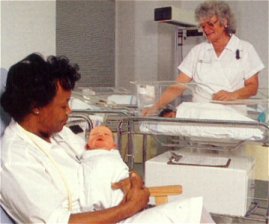| Chapter 11: | The Infant | |
| Page 8 0f 11 |
Resuscitation of Newborns
 |
Since every baby born is potentially a case for resuscitation, the skills and knowledge required for proper resuscitation are likely the most important ones possessed by caregivers that work with newborns. As a result, it is strongly recommended that each practitioner complete the Neonatal Resuscitation program offered jointly by the American Academy of Pediatrics and the American Heart Association. The information on resuscitation offered in this CEU is intended as a review, not a comprehensive course on resuscitation.
The purpose of the neonatal resuscitation is to reverse asphyxia before irreparable damage occurs. A successful resuscitation can be divided into three steps, also known as the ABCs of Resuscitation:
A-- Establish an open airway Position the infant Suction the mouth, nose, and in some instances the trachea If necessary, insert and ET tube to ensure an open airway B-- Initiate breathing Use tactile stimulation to initiate respirations Use PPV when necessary, using either: bag and mask, or bag and ET tube C-- Maintain circulation Stimulate and maintain the circulation with chest compressions and/or medications
The resuscitation procedure begins immediately at the time of birth. The procedure should follow the AHA's most current standards, and as soon as the fetus's head is presented, When the head of the fetus is presented, suctioning of the nose and mouth should begin. Apgar scores are then recorded at both one and five-minute intervals (see Table 3).
Table 3. Resuscitation and Apgar scores.
| Apgar Score | Resuscitation Efforts |
| 8 to 10 | Requires simple suctioning of airways, drying and and warming. |
| 5 to 7 | Requires gentle stimulation. If there is a failure to respond in approximately 60 seconds, assisted ventilation is required with oxygen enriched mixture. |
| 3 to 4 | Generally, these infants will respond to bag-mask ventilation alone. |
| 0 to 2 | Requires cardiopulmonary resuscitation. |
Medications that are used for resuscitation that should be readily available in the delivery room include: sodium bicarbonate, isoproterenol, dextrose, epinephrine, calcium, narcan, dopamine, atropine, and volume expanders. If endotracheal intubation is necessary, it should be performed gently.
It is necessary to have endotracheal tubes available ranging in size from 2.5 to 4.0 mm.The following table provides guidelines for choosing the proper size uncuffed tube:
| Tube Size (ID MM) | Neonate Weight | Gestational Age |
| 2.5 | <1000 g | <28 weeks |
| 3.0 | 1000-2000 g | 28-34 weeks |
| 3.5 | 2000-3000 g | 34-38 weeks |
| 4.0 | >3000 g | >38 weeks |
Effective resuscitation of newborns greatly depends on how well the delivery room and its trained personnel are prepared for handling emergencies.